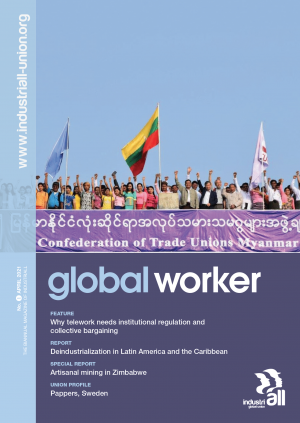Ilyenkov’s Dialectics of the Ideal and Engels’ Dialectics of Nature. On Ilyenkov’s supposed affinity with Western Marxism
Rogney Piedra
2021, Historical Materialism
30 Pages
With the current interest resurgence in E.V. Ilyenkov, the influence of Engels on him is being either overlooked or denied, picturing Ilyenkov closer to Western Marxism. In this paper, by considering Engels’ inalienable role in Ilyenkov’s philosophy, I show that his approach is fundamentally hostile to Western Marxism’s main views. Ilyenkov, who as Engels conceives philosophy as Logic, applies the principle of the ‘alliance’ relationship between philosophy and natural sciences against speculative metaphysics. He develops his original cosmological hypothesis based on Engels’ insights on the hierarchy of matter’s forms of movement. According to which, the ideal is an attribute of nature that reproduces its concrete universality through social labour, the active transformation of nature’s phenomena into objects stamped with the seal of our subjectivity. While Western Marxism’s dialectics only criticized ‘the existent’ without offering any positive way-out, Ilyenkov’s dialectics was a tool for constructing ‘the ought’, the real-ideal communist society.
https://www.academia.edu/48982697/Ilyenkov_s_Dialectics_of_the_Ideal_and_Engels_Dialectics_of_Nature_On_Ilyenkov_s_supposed_affinity_with_Western_Marxism
From the History of Soviet Philosophy: Lukacs-Vygotsky-Ilyenkov (2011)
2011, Historical Materialism
"This review-essay explores the subterranean tradition of ‘creative Soviet Marxism’1 through a recent book by the Russian philosopher Sergey Mareev, From the History of Soviet Philosophy: Lukács – Vygotsky – Ilyenkov (2008). It provides a brief overview of the history of Soviet philosophy so as to orient the reader to a set of debates that continue to be largely unexplored in the Western-Marxist tradition. Mareev offers a new account of the development of Soviet philosophy that not only explodes the myth that Soviet philosophy was simply state-sanctioned dogma, but also reinterprets the relationship between the key creative theorists so as to offer a new way of understanding its development that challenges several key-aspects of the dominant Western scholarship on this subject. He argues that alongside official Marxist philosophy in the Soviet Union – the crude materialism of Diamat and Istmat – there existed another line, which counterposed the central rôle of social activity in the development of human consciousness. He traces this line of anti-positivist theory from V.I. Lenin through Georg Lukács and Lev Vygotsky to Evald Ilyenkov – a pivotal figure in the ‘Marxian renaissance’2 of the 1960s, but who ‘has to this day remained a Soviet phenomenon without much international influence’.3 Specifically, Mareev disputes the rôle of A.M. Deborin as a precursor of the Ilyenkov school, and instead introduces Georg Lukács – a figure primarily recognised in the West as one of the founders of Western Marxism – into the line of development of creative Soviet Marxism. Furthermore, he reconsiders the rôle of V.I. Lenin and G.V. Plekhanov – the so-called father of Russian social democracy – in the development of Soviet philosophy. In the process, the author provides a detailed history of the emergence of Diamat and Istmat, and shines a spotlight on a figure widely recognised as the most important Soviet philosopher in the post-Stalin period – E.V. Ilyenkov."
https://www.academia.edu/1454708/From_the_History_of_Soviet_Philosophy_Lukacs_Vygotsky_Ilyenkov_2011_
E.V. Ilyenkov and Creative Soviet Theory: An Introduction to Dialectics of the Ideal (2012)
2012, Historical Materialism
2,498 Views24 Pages
1 File ▾
"This article aims to introduce E.V. Ilyenkov’s ‘Dialectics of the Ideal’, first published in unabridged form in 2009, to an English-speaking readership. It does this in three ways: First, it contextualises his intervention in the history of Soviet and post-Soviet philosophy, offering a window into the subterranean tradition of creative theory that existed on the margins and in opposition to official Diamat. It explains what distinguishes Ilyenkov’s philosophy from the crude materialism of Diamat, and examines his relationship to four central figures from the pre-Diamat period: Deborin, Lukács, Vygotsky, and Lenin. Second, it situates his concept of the ideal in relation to the history of Western philosophy, noting Ilyenkov’s original reading of Marx through both Hegel and Spinoza, his criticism of Western theorists who identify the ideal with language, and his effort to articulate an anti-dualist conception of subjectivity. Third, it examines Ilyenkov’s reception in the West, previous efforts to publish his work in the West, including the so-called ‘Italian Affair’, as well as existing scholarship on Ilyenkov in English."
https://www.academia.edu/1899665/E_V_Ilyenkov_and_Creative_Soviet_Theory_An_Introduction_to_Dialectics_of_the_Ideal_2012_














